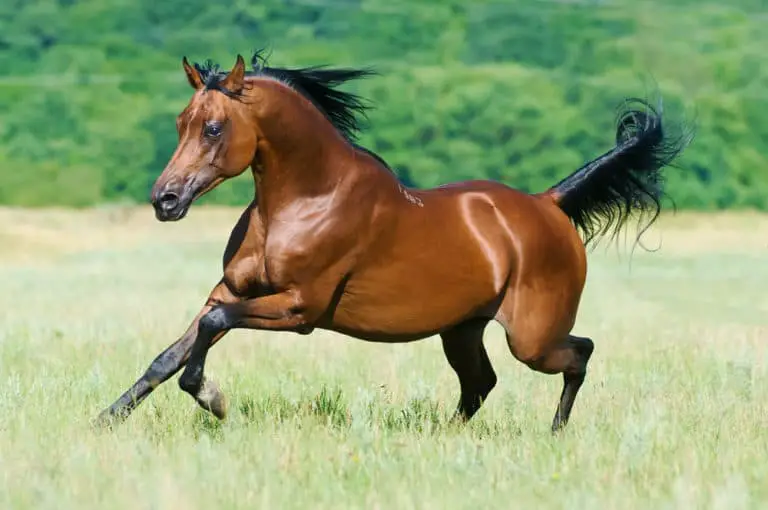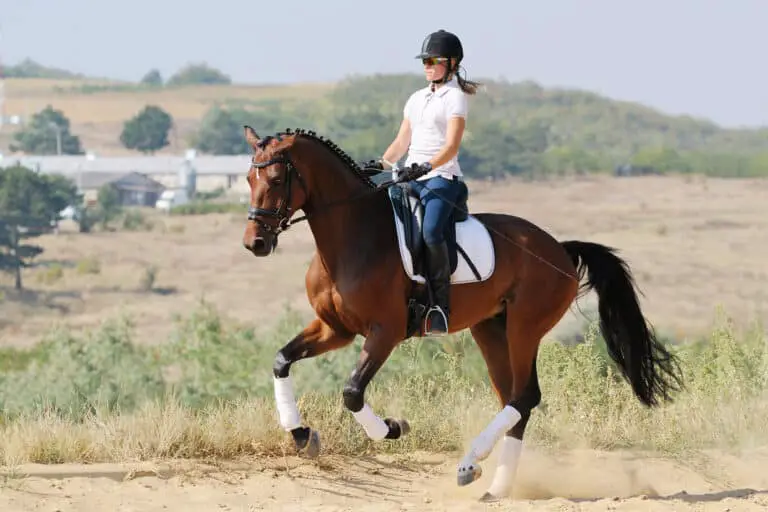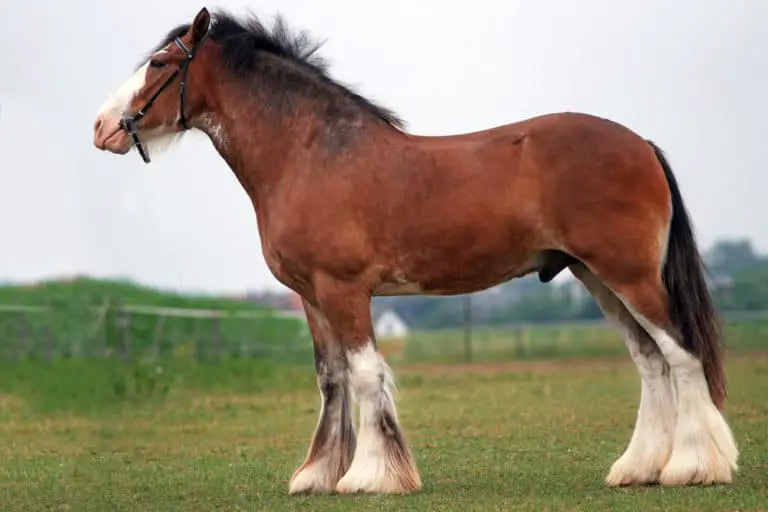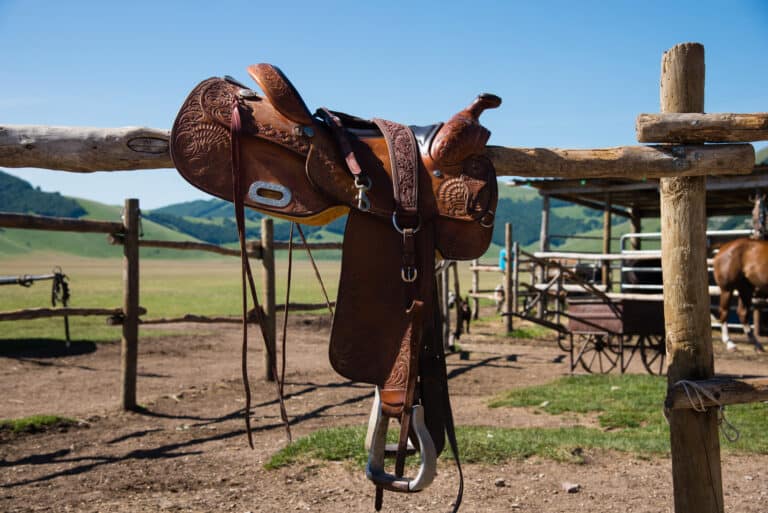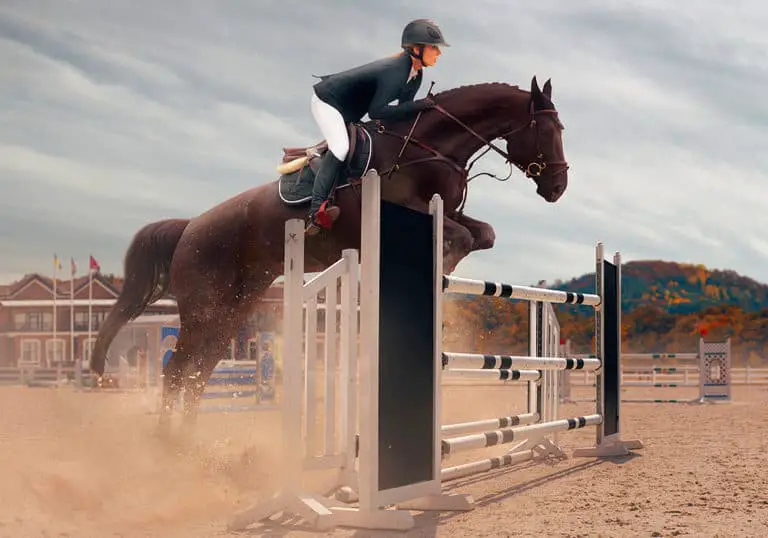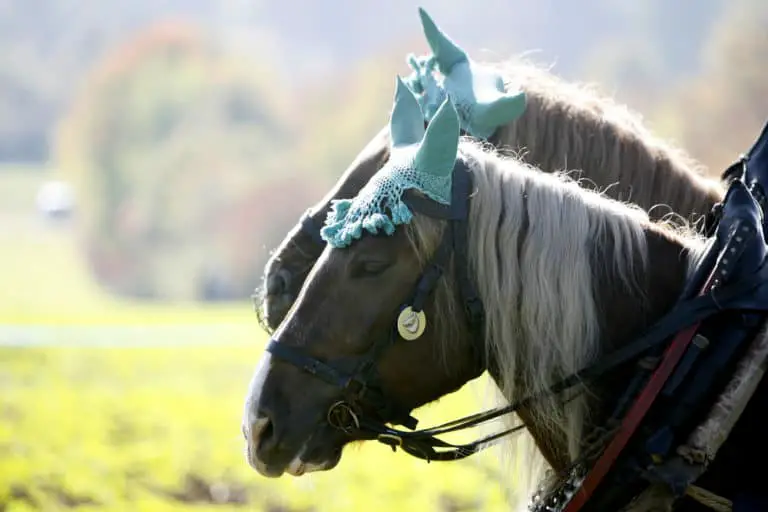Gypsy Horse Breed: Care, Cost & History (2024)
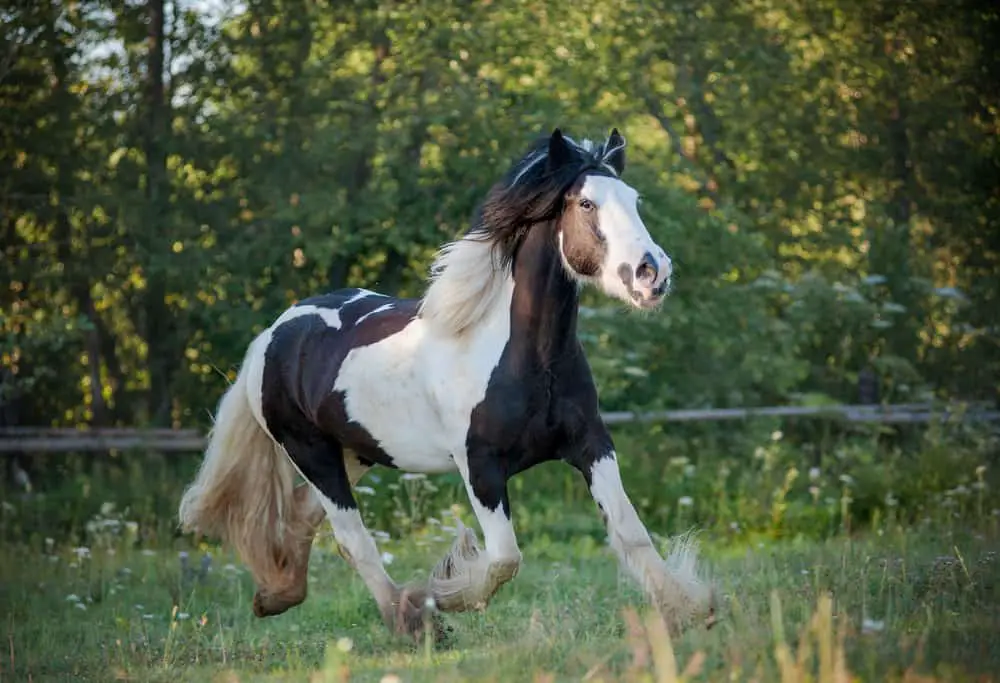
The Gypsy Horse is a popular domestic horse breed originating from Great Britain and Ireland. The white-splashed horses have been used by Irish Travelers and English Romanichal Travelers which gave the breed its name. Until this day they often pull the traditional vardos of the Romani subgroup in the British Isles.
Breed: Gypsy horse
Adult Weight: 1,100 -1,700 pounds
Adult Height: 13-15.2 hands (52 – 60,8 inches)
Origin: United Kingdom & Ireland
Use: Draught, Show, Pleasure, Jumping, Western
Colors: All colors and markings
Features: Muscular cob-type body, feathers
Lifespan: 20-25 years
Character: Intelligent, Gentle, strong nerves, willingfull
Gait: Tactful, sure-footed, well-balanced
Best for: All levels of riders
- Characteristics
- Gypsy Horse Care
- Gypsy Horse History
- Modern Gypsy Horse
- Cost and Ownership
- Buying a Gypsy Horse
- Similar Breeds
Gypsy Horse Characteristics
Gypsy horses are most often skewbald or piebald colored. They have the confirmation of a cob.
Gypsys are also called Irish Cob and they are considered small draught horses due to their strong hindquarters. Gypsy horse characteristics are characterized by a general appearance of a powerful, heavy horse with an abundance of a flowing mane, tail, and feathered legs (1).
The Gypsy horse head is supposed to be “sweet”, meaning in proportion, without coarseness, and fitting well with the balance of the overall horse. Their bite should be even (1).
Size
The Gypsy horse breed stands between 13-15.2 hands high. But the Gypsy Horse Association will accept heights outside of this range, whether above or below (1).
The Gypsy horse height can be considered average when you compare it with that of other horse breeds. Gypsy vanner size can be considered small amongst draft horses seeing that the Shire horse stands up to 18 hands high.
The Irish Cob is well-muscled with a broad, compact, and sturdy body (1). Gypsy Horses have strong and dense bones, and deep, broad, and powerful chests. Their chest should show ample muscles.
Weight
The Gypsy Horse association does not regulate or limit the weight of the Gypsy breed for registrations (1). Even though, we know that Gypsy horse weight ranges approximately between 1,100 to 1,700 pounds.
Since the Gypsy Cob has many official registries worldwide and the accepted height with each association might differ, there is a rather big weight range possible for individual horses.
Seeing that the Gypsy has strong and dense bones, they are heavier than an average light horse breed. Their strong muscles and confirmation make them heavy cob-type horses (1).
Colors
The Gypsy Horse Association accepts all colors, markings, and patterns (1). The Registry even mentions an old saying in their breed standard, saying “A good horse never comes in a bad color”.
The Gypsy Vanner is therefore not a color breed (2). Gypsy vanner colors can be colorful and diverse, meaning they can be solid, tobiano and splash.
Rare Gypsy horse colors are palomino, champagne, and cremello. The beautiful Gypsy horse most often is skewbald or piebald colored.
Those two colors are characterized by white patches on darker colored coats which is typical and characteristic for Gypsy Horses.
Temperament
Gypsy vanner behavior is known for their kindness and tolerance, intelligence, and patience.
Due to their agreeable nature, the Irish Cob is a great family horse. They are also popular as trail or therapy horses since they have an unflappable nature (2).
Gypsy horse temperament is characterized by its tractableness, and sensible and willing disposition (1). The overall temperament of a Gypsy Horse should reflect all these characteristics.
Due to their intelligence and willingness, the Irish Cob can participate in every equine discipline. They can compete in dressage, driving, jumping, and even suit as Western pleasure horses.
Gypsy Horse Care
The Gypsy horse lifespan can be up to 20-25 years. To achieve such a great age for your Gypsy, you must care for it patiently and extensively.
There is a lot to care for when it comes to Irish Cobs.
Their feathers and their weight are probably the most high-maintenance topics when it comes to caring for a Gypsy horse, but they are still considered easy keepers in the horse community.
Diet and Nutrition
The Gypsy horse diet is not very demanding when it comes to nutrients and supplements. The Gypsy Vanner needs a little more forage than the average horse. This is due to their weight and conformation. Gypsy horses need a variety of pasture, fresh hay, some grain and vegetables, and fruits (3).
Draft horses are known to have an economical metabolism which means that they can digest their nutrients slowly and therefore more efficiently (3).
Regardless of how you use your Gypsy horse, it must be fed properly. So even if you don’t use your Gypsy for pulling a vardo or farming, you must adhere to their diet. Draft Horses can be prone to obesity, so their grazing should be monitored.
Health Problems
Irish Cobs are can be prone to a few genetic problems and health issues. But overall the Gypsy Horse breed is a healthy and sturdy horse, which is also mentioned by the Gypsy Horse Association (4).
The hardy breeding conditions of Gypsy Horses made them into sturdy horses who are good jumpers, good swimmers and they are able to carry a heavy weight on their backs (4). Therefore they have strong confirmation and can withstand many obstacles.
As with all draft horse breeds, obesity is something to look out for. Do not overfeed your Gypsy and maintain a healthy diet, and practice Gypsy horse training regularly. Gypsy horses can be prone to polysaccharide storage myopathy (PSSM) and equine metabolic syndrome (EMS) (3).
Grooming
Gypsy horse grooming is one of the topics where these precious draft horses can be quite demanding. Their feathers are beautiful, but they need a lot of upkeep to avoid skin irritations and diseases.
Luckily not every gypsy vanner horse has many feathers, but most of them have feathers and you need to wash and dry the feathers of your horse at least every 3-4 days. Otherwise, you and your horse might have to deal with skin infections and irritation (5).
Brush the coat of your horse every day with a body brush to clean it from small particles and strengthen your relationship (5). Use a Curry Comb to remove more serious dirt and grease from the coat and to stimulate the blood flow (5).
Gypsy Horse History
The Gypsy horse history is not as old as that of other breeds, but it is still very interesting and North America has played a huge role in the development of the Gypsy Vanner Horse. The small draft horses of the British Isles were used and bred by English Romanichal and Irish Travelers.
Origin
The Irish Cob originates from the British Isles and has been used by Irish Travellers and a Romani subgroup for traveling through the Isles.
Those travelers did not use horses for their travels until the latter part of the 19th century. From then on the nomadic Travelers used horses to pull their vardos which led to the breeding of Gypsy Horses.
As with every horse breed, a new breed results from crossbreeding existing breeds by people who wanted to breed a distinctive-looking horse for a specific purpose.
The original breeding goal of the English Romanichal was the ideal caravan horse (2). The Gypsy horse origin includes the Shire, the Clydesdale, and native British ponies such as the Dales (2).
Historic Development
After the Second World War, the English Romanichal has the vision to create the perfect caravan horse; “a small Shire, with more feather, more color, and a sweeter head” was their original breeding goal (2).
Most parts of this selective breeding by the English Romanichal were practiced almost unknown to the equestrian world for many decades until Dennis and Cindy Thompson, two Americans, were traveling through the English countryside and spotted a horse breed unknown to them in the fields (2).
The Thompsons helped create the nowadays known Gypsies’ “vanner” breed by connecting with the English Romanichal travelers and taking the first horses to the US (2).
Notable Gypsy Horses
Since we know that Gypsy Horses were unknown to the outside world for a long time, there has not been too much time for the breed to get famous. Still, there are some famous Gypsy horses
that hold records or won in competitions. There are some Gypsy vanner pedigrees that produced well-known horses as well.
The Gypsy King
The Gypsy Kind is a black and white tobiano stallion. He was the sire of 84 foals and the first Gypsy stallion that was imported to the US by the Thompsons in 1998. Gypsy Kind is probably the most famous and recognized horse of the Irish Cob breed in the world.
Birthday Boy King
Birthday Boy King was born on Cindy Thompson’s birthday and is a stunning black Blagdon stallion that lives at the Appleby equestrian center. He has a prominent blaze, three stockings, and a sock. Birthday Boy King was sired by the famous The Gypsy King who was the first Irish Cob in the US.
VV King William
The black and white tobiano stallion VV King William was born in 2007 and stands at 15 hands at the withers. He has welcomed around 35 foals and was sired by the legendary The Gypsy King himself. VV William is father to multiple champion offspring, including Champion and Hall of Fame Stallion GG Lyuba’s King Zeus.
Myths and Legends
We do not know of many myths and legends surrounding the Irish Cob since the breed is just known to the equestrian community since the late 19th century. Gypsy horse legends originate from the English Romanichal community mostly.
Verbal History
The first studbook of the Irish Cob wasn’t introduced until the late 19th century. The breeding goals and history of the Gypsy Vanner were passed down verbally by the English Romanichal and Irish Travelers, which is why we do not know about their old history.
Ireland, not Great Britain
It may be confusing for some people, why the Gypsy Horse has so many names with one of them being Irish Cob. The reason for their many names is, that the Gypsy Vanner, as it is called in the US, truly originated from Ireland and not the UK.
Fairytale Horse
The Irish Cob does not only look magical, but some local folks in Ireland do whisper the horses might have connections to the fairies and leprechauns. They are also called Tinker Horses in Ireland and we all know the fairy Tinkerbell from Peter Pan. A naysayer might say it’s just a coincidence, but maybe you believe in magic.
Modern Gypsy Horses
After many years of being an unknown breed to the outside world, the Gypsy vanner has become a popular and beloved horse worldwide. Especially in the US, the UK, and Ireland, the different types of Gypsy horses are popular family or pleasure horses. Their kind nature and solid built make them allrounders and breeding has increased over the last years.
Breeding
Due to their history and the interest of the Thompson family in Gypsy horse breeding, the cob-breed has become popular in the US. But also in their home countries, Ireland and the UK, the Gypsy Horse is more famous than ever and you can spot them all over the countryside.
Many families have a Gypsy gelding on their farm or have them as family pets due to their kind nature. Even though most owners of Gypsy horses are not living nomadic and do not own vardos, the Gypsy Horse Association still remained the original breeding goal of the English Romanichal (1).
Population
There are approximately 10,000 Gypsy Vanner horses in the world today. It must be noted that of these horses around 20% of them are selectively bred to maintain the breeds standards.
There are no definitive numbers regarding the Gypsy horse population, but it is estimated that 20% of the global population of the Irish Cobs live in the United States.
Even though the number of Gypsy Vanners might seem small in comparison with American Quarter horses or other popular breeds, it must be noted that the small number of horses is reasoned to the very young breeding history of the breed (1).
Uses
Gypsy horse uses are versatile and the Gypsy Horse Association even claims that the Irish Cob is, “beyond doubt, the most versatile of animals in existence and long ago established a reputation as the best ride and drive animal in the world.” (1).
The Gypsy vanner gait is powerful, agile, and well-balanced which makes them successful dressage horses.
Gypsy Horses have a good depth of body and are well suited for riding or driving. (1) Their kind nature and character make them ideal horses for any use. They are naturally gifted jumpers and therefore even compete in jumping and dressage.
Gypsy Horse Prices
When it comes to the Gypsy horse price, many people only think about the actual purchase price of the horse.
But owning a horse comes with monthly and regular costs that can’t be avoided or skipped.
Once you have purchased a Gypsy Horse, you will need to pay for monthly ownership costs which include boarding, feed, vet care, and hoofing care.
Purchase Price
Even though the Gypsy Horse is not considered a rare or expensive breed, the price of a Gypsy horse can ultimately be more expensive compared to other popular breeds like Thoroughbreds or American Quarter Horses.
This is because there are not many Gypsy Vanner breeders in the US and the horse has only been imported into the US a few decades ago which limits the total number of available horses and increases the Gypsy price.
As with all horse breeds the pedigree, health status, training, and physical data determine the initial purchase price.
The average Gypsy stallion costs between $1,200 to $25,000 (6). A Gypsy foal can cost as little as $120 if you purchase it in Ireland, but the import costs to the US can cost up to $7,500 (6). A good Gypsy Vanner will cost $3,400 to $5,400 with the highest-quality Gypsys costing around $25,000 (6).
Ownership Costs
It is essential that when you decide to buy a Gypsy horse, you are aware of the Gypsy horse cost of ownership that comes with owning your horse.
The monthly costs of ownership should be taken into consideration: board, feed, veterinarian care, and hoof care are just some of the regular costs which can easily be as high as $1,000 a month.
Board
Boarding is a significant and very expensive factor in the costs of horsemanship. You will most likely have to pay monthly fees for the Gypsy Horse board cost if you do not own a smallholding or stable yourself.
Keeping a horse near a big city will be more expensive than stalling them in areas where there are many equestrians already. Boarding costs can range from 175$ per month for simple boarding to 750$ a month for show boarding or 650$ for full board (7).
Feed
The Gypsy horse feed cost will be similar to that of other horse breeds since their metabolism works slower and digests more efficiently. Gypsys are natural grazers like every other horse breed and mainly eat hay and grass.
The estimated daily water intake of a Gypsy is around 2.4 – 8.3 liters per day, and their estimated daily food intake is approximately 15-30 bales of hay. A bale of hay will cost around 2$ up to 14$ depending on the region you live. The total costs of supplements and feed will cost approximately $1,400 a year (8).
Veterinary Care
The Gypsy horse veterinary cost will be approximately $1,291 a year if you set up a care plan (8). These costs cover annual vaccinations, deworming for 12 months, and teeth floating once per year.
However, these costs do not cover anything unexpected like injuries, inflammations, or colics. One of those alone can cost up to $500-$1,200 depending on the severity of the problem.
Gypsy horses can be prone to obesity and skin irritation which is why they should be monitored regularly for their dietary intake and skin health.
Hoof Care
The Gypsy horse hoof care cost will be a regular expense even if your Gypsy does not wear shoes. Horses need to get new shoes or a trim every 6-8 weeks, and the costs of hoof care must be considered a regular expense (8).
Full-shoeing a horse’s hooves will cost around $1,300 a year. Front-Shoeing, your horse, will cost about 650$ a year and even just a trim of the hooves can cost up to 346$ a year (8).
Buying a Gypsy Horse
A horse of the Gypsy breed can be purchased easily in the UK, the US, Ireland, and Germany. It can be hard to find a registered Gypsy in other countries. But no matter where you buy your Gypsy, you need to be aware of what is important during a horse purchase.
First and foremost of all, the horse of your interest should be healthy and suitable for your intended use: for pleasure, for dressage, or as a farm animal? Look for a breeder you can trust and who has a good relationship with his animals, rather than a moneymaking horse mill.
Is the Gypsy Horse Right for You?
The Gypsy Horse will be a great choice for almost every horse enthusiast. Riding a Gypsy horse will be a great joy for all-level riders and the whole family.
Owning a Gypsyhorse is the right choice for families, competitive riders, and beginners since the Gypsy is a very versatile horse with a kind, yet willing full temperament. They are suitable as family horses or for experienced riders who like to compete with their horse professionally.
Keep in mind, that a Gypsy Horse is a heavy horse and has feathers that need a lot of upkeep. You will need a lot of time and patience to care for a horse that big.
How to Buy a Gypsy Horse?
First, look for a Gypsy horse breeder of your choice and visit their stud. Buying a Gypsy horse is a big commitment and should not be done in a rush. The breeder should have a clean and well-organized stud with not too many horses.
Look out for the interaction between the breeder and the Gypsy Horse of your choice. Does it seem trusting, or frightened and distanced? Keep in mind, that if you buy a Gypsy Horse overseas, you will need to pay a considerable sum of money to import your horse. Flying is very stressful for animals and should be avoided, if possible.
If you feel like the breeder wants to do a quick sell or avoids your questions, rather walk away. Interact with the Gypsy horse and talk with the breeder about his experience with the horse. What is it like? Will you be a good fit for each other?
Similar Breeds to Gypsy
There are Gypsy breed alternatives with horses that share some of their distinctive features. Similar breeds to a Gypsy are the Clydesdale, the Icelandic Horse, and the Friesian Horse.
Some of those breeds are slightly taller, smaller, or more experienced for dressage or showjumping and therefore offer good alternatives to a Gypsy Horse.
Icelandic
The Icelandic is a sturdy and hardy pony that has a similar look to the Gypsy Horse but is considerably smaller and almost pony-sized. Icelandics have a great personality and are wonderful alternatives for adult pony fans that want to be in the saddle.
Friesian Horse
The Friesian Horse is a beautiful black horse breed that looks similar to the Gypsy Horse. This is because they also have feathers, though slightly more voluminous than a Gypsy. Friesians have a black coat and are also used for dressage extensively since their body type is more allowing for delicate movement than that of some Gypsy Horses.
Clydesdale
The Clydesdale can be described as the taller Scottish cousin of the Gypsy Horse. It is a draught horse as well and the uses of both breeds are similar with the Gypsy horse being more versatile. Clydesdales are taller than Gypsy Horse and they are named after the River Clyde in Scotland. If you look for a taller version of the Gypsy, that can even pull more weight, this breed might be a great alternative for you.
FAQ
What is a Gypsy horse?
The Gypsy Horse is a popular domestic horse breed originating from Great Britain and Ireland.
What does a Gypsy horse look like?
Gypsy horses are most often skewbald or piebald colored horses with the confirmation of a cob.
How did the Gypsy horse get its name?
The white-splashed horses have been used by Irish Travelers and English Romanichal Travelers which gave the breed its name.
Can you ride a Gypsy horse?
Yes, a Gypsy Horse can be ridden.
Are Gypsy horses good for beginners?
Yes, Gypsy Horses are good for beginners due to their kind nature.
How tall is a Gypsy horse?
The Gypsy horse breed stands between 13-15.2 hands high (52 – 60,8 inches)
How much does a Gypsy horse weigh?
The Gypsy horse weighs approximately between 1,100 to 1,700 pounds.
How big is a Gypsy horse?
Gypsy horses are small draft horses with compact and muscular bodies.
How much does a Gypsy horse cost?
The average Gypsy stallion costs between $1,200 to $25,000.
How much does Gypsy horse ownership cost?
Despite the initial purchase price, boarding costs can range from 175$ per month up to 750$ a month for show boarding.
How long do Gypsy horses live?
Gypsy horses live between 20-25 years.
How fast can a Gypsy horse run?
A healthy Gypsy can gallop between 40 to 48 kilometers per hour (25 to 30 mph).
How much can a Gypsy horse pull?
Gypsy Horses can pull heavy caravans and a lot of weight.
How much can a Gypsy horse carry?
A Gypsy Horse can carry between 200 and 260 pounds.
At what age is a Gypsy horse full grown?
Gypsy Horses are fully grown at the age of 4-6 years.
What are Gypsy horses used for?
Gypsy Horses can be used versatile for every equine discipline including driving, dressage, jumping, and Western.
References
- Gypsy Horse Association. 2022. Breed Standard. Link
- Gypsy Vanner Horse Society. 2022. The Gypsy Vanner Horse Breed. Link
- Kentucky Equine Research. 2011. Nutritional Management of Draft Horses. Link
- Gypsy Horse Association. 2022. Breed. Link
- The Horse. 2004. Heavy Horse Health Problems. Link
- Gypsy Gold. 2022. The Breed Standard and GV Facts and Fiction. Link
- New Horse. 2022. Horse Boarding. Link
- Equine Guelph. 2022. Annual Horse Expense Sheet. Link

